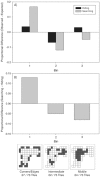Not all locations are created equal: exploring how adults hide and search for objects
- PMID: 22606324
- PMCID: PMC3350504
- DOI: 10.1371/journal.pone.0036993
Not all locations are created equal: exploring how adults hide and search for objects
Abstract
Little is known about the strategies people use to effectively hide objects from others, or to search for objects others have hidden. The present research extends a recent investigation of people's hiding and searching strategies in a simple room with 9 cache location. In the present studies, people hid and searched for three objects under more than 70 floor tiles in complex real and virtual rooms. Experiment 1 replicated several finding of Talbot et al within the more complex real and virtual environments. Specifically, people traveled further from origin and selected more dispersed locations when hiding than when searching. Experiments 2 and 3 showed that: 1) people were attracted to an area of darkness when searching and avoided locations close to a window when hiding, 2) when search attempts were limited to three choices, people searched farther from origin and dispersed their locations more when hiding than when searching, and 3) informing people that they would need to recover their hidden objects altered their hiding behavior and increased recovery accuracy. Across all experiments, consistencies in location preferences emerged, with more preference for the middle of the room during hiding and more preference for corners of the room during searching. Even though the same people participated in both the hiding and searching tasks, it appears that people use different strategies to select hiding places than to search for objects hidden by others.
Conflict of interest statement
Figures













References
-
- Dally JM, Emery NJ, Clayton NS. Cache protection strategies by western scrub-jays, Aphelocoma californica: Implications for social cognition. Anim Behav. 2005;70:1251–1263.
-
- Heinrich B, Pepper J. Influence of competitors on caching behaviour in the common raven (Corvus corax). Anim Behav. 1998;56:1083–1090. - PubMed
-
- Elazary L, Itti L. A Bayesian model for efficient visual search and recognition. Vision Res. 2010;50:1338–1352. - PubMed
Publication types
MeSH terms
LinkOut - more resources
Full Text Sources

